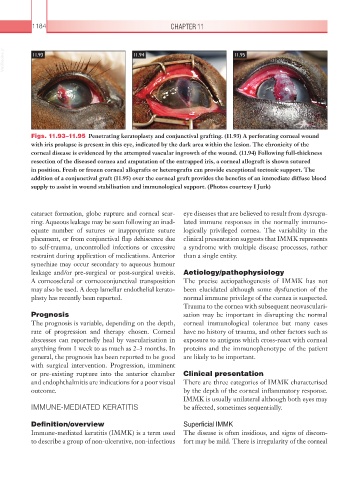Page 1209 - Equine Clinical Medicine, Surgery and Reproduction, 2nd Edition
P. 1209
1184 CHAPTER 11
VetBooks.ir 11.93 11.94 11.95
Figs. 11.93–11.95 Penetrating keratoplasty and conjunctival grafting. (11.93) A perforating corneal wound
with iris prolapse is present in this eye, indicated by the dark area within the lesion. The chronicity of the
corneal disease is evidenced by the attempted vascular ingrowth of the wound. (11.94) Following full-thickness
resection of the diseased cornea and amputation of the entrapped iris, a corneal allograft is shown sutured
in position. Fresh or frozen corneal allografts or heterografts can provide exceptional tectonic support. The
addition of a conjunctival graft (11.95) over the corneal graft provides the benefits of an immediate diffuse blood
supply to assist in wound stabilisation and immunological support. (Photos courtesy I Jurk)
cataract formation, globe rupture and corneal scar- eye diseases that are believed to result from dysregu-
ring. Aqueous leakage may be seen following an inad- lated immune responses in the normally immuno-
equate number of sutures or inappropriate suture logically privileged cornea. The variability in the
placement, or from conjunctival flap dehiscence due clinical presentation suggests that IMMK represents
to self-trauma, uncontrolled infections or excessive a syndrome with multiple disease processes, rather
restraint during application of medications. Anterior than a single entity.
synechiae may occur secondary to aqueous humour
leakage and/or pre-surgical or post-surgical uveitis. Aetiology/pathophysiology
A corneoscleral or corneoconjunctival transposition The precise aetiopathogenesis of IMMK has not
may also be used. A deep lamellar endothelial kerato- been elucidated although some dysfunction of the
plasty has recently been reported. normal immune privilege of the cornea is suspected.
Trauma to the cornea with subsequent neovasculari-
Prognosis sation may be important in disrupting the normal
The prognosis is variable, depending on the depth, corneal immunological tolerance but many cases
rate of progression and therapy chosen. Corneal have no history of trauma, and other factors such as
abscesses can reportedly heal by vascularisation in exposure to antigens which cross-react with corneal
anything from 1 week to as much as 2–3 months. In proteins and the immunophenotype of the patient
general, the prognosis has been reported to be good are likely to be important.
with surgical intervention. Progression, imminent
or pre-existing rupture into the anterior chamber Clinical presentation
and endophthalmitis are indications for a poor visual There are three categories of IMMK characterised
outcome. by the depth of the corneal inflammatory response.
IMMK is usually unilateral although both eyes may
IMMUNE-MEDIATED KERATITIS be affected, sometimes sequentially.
Definition/overview Superficial IMMK
Immune-mediated keratitis (IMMK) is a term used The disease is often insidious, and signs of discom-
to describe a group of non-ulcerative, non-infectious fort may be mild. There is irregularity of the corneal

